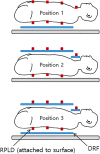Shielding effect of radiation dose reduction fiber during the use of C-arm fluoroscopy: a phantom study
- PMID: 32766722
- PMCID: PMC7482166
- DOI: 10.1093/jrr/rraa060
Shielding effect of radiation dose reduction fiber during the use of C-arm fluoroscopy: a phantom study
Abstract
This study evaluated the shielding effect of a newly developed dose-reduction fiber (DRF) made from barium sulfate, in terms of radiation doses delivered to patients' radiosensitive organs and operator during C-arm fluoroscopy and its impact on the quality of images. A C-arm fluoroscopy unit was placed beside a whole-body phantom. Radiophotoluminescent glass dosimeters were attached to the back and front of the whole-body phantom at 20 cm intervals. Radiation doses were measured without DRF and with it applied to the back (position 1), front (position 2) or both sides (position 3) of the phantom. To investigate the impact of DRF on the quality of fluoroscopic images, step-wedge and modulation transfer function phantoms were used. The absorbed radiation doses to the back of the phantom significantly decreased by 25.3-88.8% after applying DRF to positions 1 and 3. The absorbed radiation doses to the front of the phantom significantly decreased by 55.3-93.6% after applying DRF to positions 2 and 3. The contrast resolution values for each adjacent step area fell in the range 0.0119-0.0209, 0.0128-0.0271, 0.0135-0.0339 and 0.0152-0.0339 without and with DRF applied to positions 1, 2 and 3, respectively. The investigated DRF effectively reduces absorbed radiation doses to patients and operators without decreasing the quality of C-arm fluoroscopic images. Therefore, routine clinical use of the DRF is recommended during the use of C-arm fluoroscopy.
Keywords: C-arm fluoroscopy; barium sulfate; dose reduction fiber; radiation dose.
© The Author(s) 2020. Published by Oxford University Press on behalf of The Japanese Radiation Research Society and Japanese Society for Radiation Oncology.
Figures






Similar articles
-
Effect of metallic tools on scattered radiation dose during the use of C-arm fluoroscopy in orthopaedic surgery.J Radiat Res. 2019 Jan 1;60(1):1-6. doi: 10.1093/jrr/rry073. J Radiat Res. 2019. PMID: 30247685 Free PMC article.
-
Measurements of surgeons' exposure to ionizing radiation dose: comparison of conventional and mini C-arm fluoroscopy.J Hand Surg Eur Vol. 2016 Mar;41(3):340-5. doi: 10.1177/1753193415590388. Epub 2015 Jun 26. J Hand Surg Eur Vol. 2016. PMID: 26115681
-
Types and arrangement of thyroid shields to reduce exposure of surgeons to ionizing radiation during intraoperative use of C-arm fluoroscopy.Spine (Phila Pa 1976). 2013 Nov 15;38(24):2108-12. doi: 10.1097/BRS.0b013e3182a8270d. Spine (Phila Pa 1976). 2013. PMID: 23963017
-
Performances of a protector against scattered radiation during intraoperative use of a C-arm fluoroscope.J Radiol Prot. 2016 Sep;36(3):629-640. doi: 10.1088/0952-4746/36/3/629. Epub 2016 Aug 12. J Radiol Prot. 2016. PMID: 27517131
-
Feasibility of Reducing Animal Numbers in Radiation Countermeasure Experiments from Historic Levels when using Sample Size Calculations.Radiat Res. 2023 Aug 1;200(2):107-115. doi: 10.1667/RADE-22-00124.1. Radiat Res. 2023. PMID: 37327124 Free PMC article. Review.
References
-
- Gavit L, Carlier S, Hayase M et al. . The evolving role of coronary angiography and fluoroscopy in cardiac diagnosis and intervention. EuroIntervention 2007;2:526–32. - PubMed
-
- Huang AJ. Fluoroscopically guided lumbar facet joint injection using an interlaminar approach and loss of resistance technique. Skeletal Radiol 2016;45:671–6. - PubMed
-
- Dawe EJ, Fawzy E, Kaczynski J et al. . A comparative study of radiation dose and screening time between mini C-arm and standard fluoroscopy in elective foot and ankle surgery. Foot Ankle Surg 2011;17:33–6. - PubMed
-
- Shoaib A, Rethnam U, Bansal R et al. . A comparison of radiation exposure with the conventional versus mini C arm in orthopedic extremity surgery. Foot Ankle Int 2008;29:58–61. - PubMed
-
- Mesbahi A, Rouhani A. A study on the radiation dose of the orthopaedic surgeon and staff from a mini C-arm fluoroscopy unit. Radiat Prot Dosimetry 2008;132:98–101. - PubMed
MeSH terms
Substances
LinkOut - more resources
Full Text Sources

